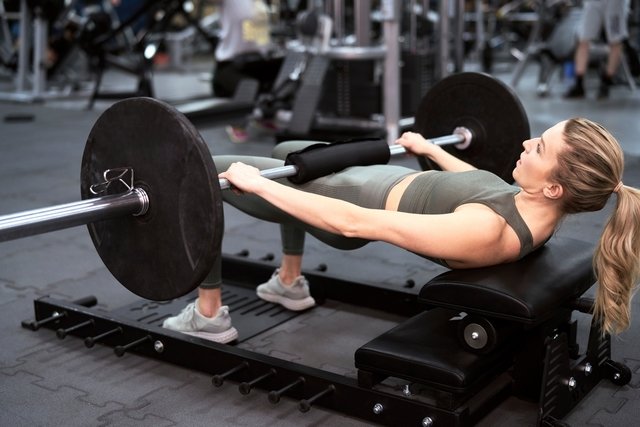Pelvic elevation, or hip elevation, is a highly recommended exercise for strengthening and increasing the glutes, in addition to working the muscles of the abdomen, thighs, sides of the hips and lumbar spine.
Pelvic elevation can be done at home or in the gym, with your body weight or using weights, such as dumbbells or weight plates. Furthermore, this exercise can also be done with accessories, such as bosu, ball, bar, mini band or even with the use of machines, such as smith or hip thrust machine.
There are different types of this exercise, such as unilateral pelvic lift, pelvic lift on the machine and pelvic lift on the smith. However, it is important that the pelvic lift is initially done with the guidance of a physical education professional, to perform the movement correctly and avoid injuries.

What is it for
The main indications for pelvic elevation are:
- Strengthen the gluteal muscles;
- Increase glutes;
- Strengthen the lumbar spine;
- Improve posture and balance;
- Work the thigh and hip muscles;
- Strengthen the abdomen.
The pelvic lift mainly works the medius, maximus and hamstring muscles of the glutes, which are important for improving hip flexibility, providing stability and balance when walking, running or jumping. In addition, pelvic elevation also helps prevent injuries and pain in the lumbar spine, knees and hips.
Types of pelvic lift
The most common types of pelvic lift include:
1. Unilateral pelvic lift
Unilateral pelvic elevation is an exercise that can be done at home or in the gym, using a mini band, dumbbells or weight plates, on the floor or on a bench. This exercise is highly recommended for further strengthening the lumbar spine and increasing the glutes. Discover other exercises recommended for glutes.
How to make: lie on a mat, face up and with your hands extended along your body. Bend your knees, hip-width apart and place your feet firmly on the floor. Fully straighten your right leg and raise your hips, inhaling, pushing the floor with your left heel and contracting your glutes and abdomen. Slowly lower your hips, without touching the floor, exhaling, keeping your glutes contracted and continuing the exercise. You can do 3 to 4 sets, with 8 to 15 repetitions on each side.
Unilateral pelvic elevation can also be done on a bench, resting your back on a bench and raising your hips until your legs are at a 90º angle.
2. Pelvic lift on the machine
The pelvic lift on the machine is done in a device known as an articulated pelvic lift or hip thrust machine, which can be found in some gyms. This type of pelvic lift can be recommended for people who want to add a lot of weight to the exercise or who need more stability and comfort for their back.
How to make: sit on the machine, adjust the height of the bench and add the desired weight. Keep your feet firmly on the platform of the device and raise your hips, placing strength in your heels and contracting your glutes and abdomen well. You can do 3 to 4 sets, 8 to 15 repetitions, depending on your goals.
3. Pelvic lift in smith (500)
Pelvic elevation in smith It can replace lifting on a machine or pelvic lifting with a bar, being very easy to place the weights and thus helping to develop the gluteal muscles.
How to make: To do this exercise, you must place a bench at a distance from the smith where the machine’s bar is positioned in line with your hips. Support your back, placing your shoulder blades on the bench. Place your feet on the floor at a 45º angle, hip-width apart, and your knees aligned with your heels.
Unlock the bar and slightly raise your hips, squeezing your glutes tightly and raising them until your hips are in line with your knees. Lower your hips slowly and repeat the movements. Do 3 to 4 sets, with 8 to 15 repetitions each.
4. Pelvic floor lift
The pelvic floor lift can be done at home or in the gym. To do this exercise, simply lie on a mat, face up, and place both feet on the floor, hip-width apart. Inhale and raise your hips, contracting your glutes and abdomen, until your hips are aligned with your knees. Slightly lower your hips, inhaling, and repeat the movements.
In addition, pelvic elevation can also be done using a mini band, dumbbells or weight plates.
- Pelvic floor lift with mini band: lie on a mat face up and place the mini band above your knees. Place both feet on the floor, hip-width apart, and raise your hips, pushing the floor with your heels and contracting your glutes and abdomen;
- Pelvic raise on the floor with dumbbell or weight plate: To do this type of lift, you can place dumbbells or weight plates on your hip bones, and then raise your hips, pushing the floor with your heels.
You can do 3 to 4 sets, with 8 to 15 repetitions of the pelvic raise on the floor, with an interval of 45 to 60 seconds between each repetition.
5. Pelvic bench raise
The pelvic lift on the bench is similar to the pelvic lift on the floor, but you must support your back on a bench and can be done without weight or with a barbell, dumbbell or kettlebell, for example.
How to make: position your back on a bench, supporting the part below your shoulder blades. Place your feet on the floor, with your knees bent and hip-width apart. Push through your heels, raising your hips, until your thighs are parallel to the floor, forming a 90-degree angle. Slowly lower your hips and repeat the movement. You can do 3 to 4 sets, with 8 to 15 repetitions each.
To do the pelvic lift on the bench with weight, you can place a barbell, dumbbell or kettlebell supported on the hips and then do the exercise.
6. Pelvic lift on the Swiss ball
The pelvic elevation on the Swiss ball increases the range of this exercise, helping to strengthen the glutes, in addition to working the lower back and core, which is the muscles in the central region of the abdomen.
How to make: lie on your back on a mat, leave your arms stretched along your body and rest your feet on the Swiss ball. Slowly raise your hips, without moving the ball, breathing in and contracting your glutes and abdomen well. Slowly lower your hips, exhaling, without touching your buttocks to the floor, and start again. Do 3 to 4 sets, with 8 to 15 repetitions each.
The pelvic lift on the Swiss ball can also be unilateral. To do this, simply place one of your feet on the ball and leave the other leg stretched facing the ceiling, and do the exercise.
7. Pelvic lift on the bosu
For those who still cannot do the pelvic lift on the ball, this exercise can also be done on the bosu, a type of ball that contains a semi-spherical plastic part and a rubber or plastic base, which can be used on both sides.
How to make: lie on a mat with your back on the floor and your arms extended along your body. Place your feet on the bosu and leave your legs hip-width apart. Inhale and raise your hips, contracting your glutes well. Slightly lower your hips, inhaling, and repeat the movement. You can do 3 or 4 sets, of 8 to 15 repetitions each.
Just like the elevation on the ball, the pelvic elevation on the bosu can also be unilateral. To do this, simply place one of your feet on the bosu and stretch the other leg, leaving it facing the ceiling, and perform the movements.

Sign up for our newsletter and stay up to date with exclusive news
that can transform your routine!
Warning: Undefined array key "title" in /home/storelat/public_html/wp-content/plugins/link-whisper-premium/templates/frontend/related-posts.php on line 12
Warning: Undefined array key "title_tag" in /home/storelat/public_html/wp-content/plugins/link-whisper-premium/templates/frontend/related-posts.php on line 13



